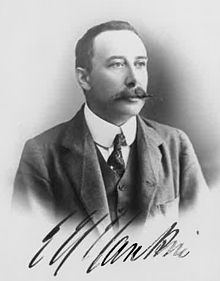Ernest Hanbury Hankin | |
|---|---|
 A carte de visite portrait taken around 1900 at Agra. | |
| Born | 4 February 1865 Ware, Hertfordshire, England |
| Died | 29 March 1939 (aged 74) |
| Alma mater | St John's College, Cambridge |
| Known for | Bacteriophages |
| Scientific career | |
| Fields | Bacteriology Aeronautics Natural history Islamic geometric patterns |
Ernest Hanbury Hankin (4 February 1865 – 29 March 1939) was an English bacteriologist, aeronautical theorist and naturalist. Working mainly in India, he studied malaria, cholera and other diseases. He is often considered as among the first to detect bacteriophage activity and suggested that their presence in the waters of the Ganges and Yamuna rivers may have had a role in restricting the outbreaks of cholera. Apart from his professional studies, he took considerable interest in the Islamic geometric patterns in Mughal architecture ("Saracenic art" in the language of his day) as well as the soaring flight of birds, culture and its impact on education.[1] He was sometimes criticised for being overzealous in his research methods.
- ^ (H.H.B.) (1939). "Obituary | Ernest Hanbury Hankin" (PDF). The Eagle. 51 (223): 181–183.
